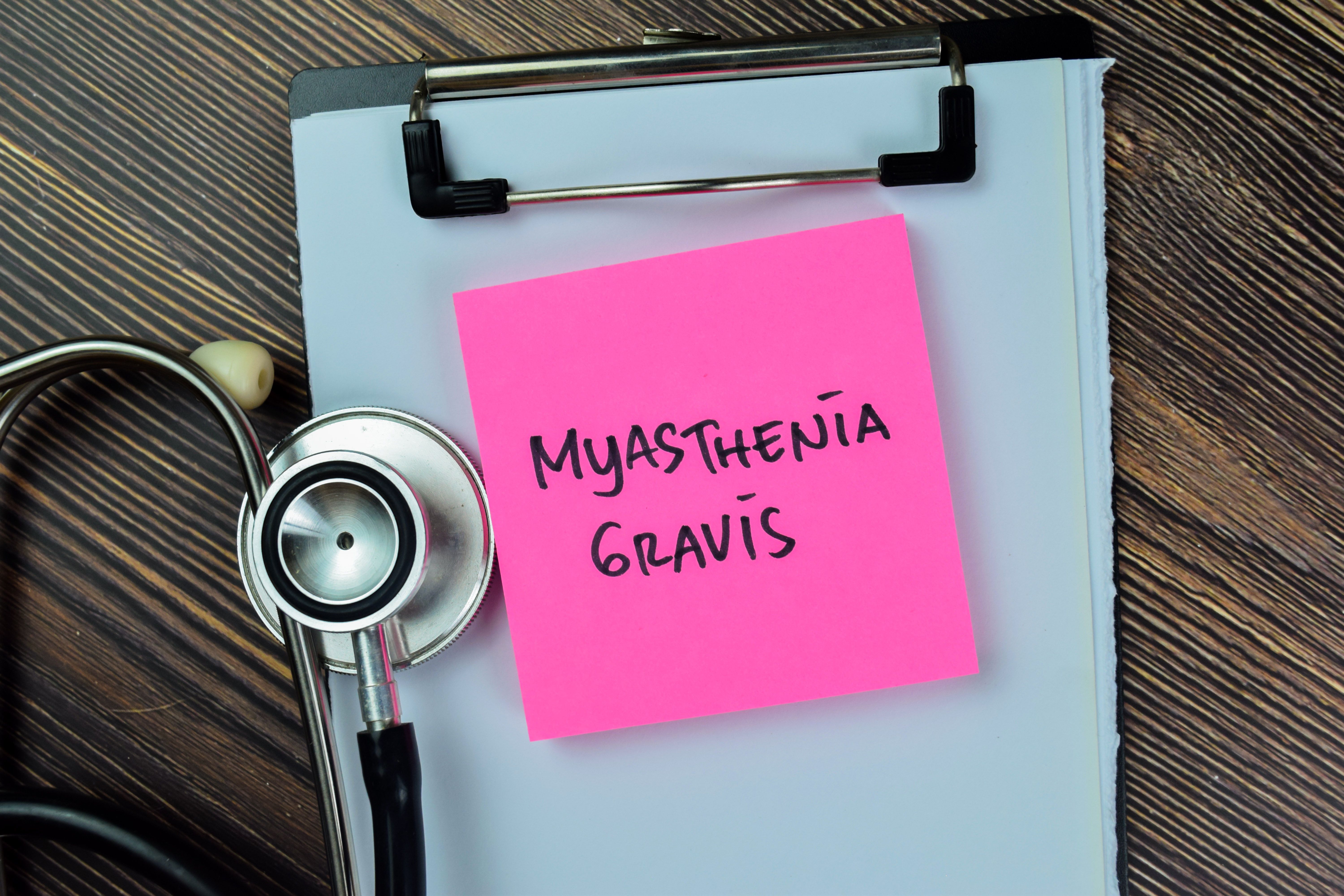News
Article
Low-Dose Rituximab Effective Against MuSK-Positive MG in New Analysis
Author(s):
Following implementation of low-dose rituximab as standard of care for muscle-specific kinase–positive myasthenia gravis (MuSK-MG), a hospital evaluated the treatment’s efficacy over a 2-year period.
Notes on myasthenia gravis
Image Credit: syahrir - stock.adobe.com

For patients who have muscle-specific kinase–positive myasthenia gravis (MuSK-MG), low-dose rituximab was proved effective, according to a new analysis published in Neuroscience Letters that evaluated disease severity before and after treatment in the Neurology Department of First Hospital, Shanxi Medical University, from April 2021 to April 2023.1
Following research that showed rituximab was an effective treatment for MuSK-MG,2-5 the investigators implemented the treatment at their hospital. Compared with high-dose rituximab, additional benefits of low-dose rituximab include lower risks of myocardial infarction, spondylodiscitis, neutropenia, and diverticulitis.
This retrospective analysis covered 9 patients (8 female patients) with MuSK-positive disease of the 204 patients who had MG and were admitted. Their age range was 20 to 73 years; disease duration, 3 to 56 months; and follow-up, 3 to 21 months. Most presented with ptosis and/or diplopia. They received 1 to 4 cycles of low-dose rituximab, which entailed an induction regimen of 100 mg on day 1 and 200 mg each on days 2 and 3 and subsequent 500-mg treatments very 6 months or yearly. Baseline measures were taken on day 1. Effectiveness was evaluated via Myasthenia Gravis Foundation of America (MGFA) classification; Myasthenia Gravis Foundation of America-Post Intervention Status (MGFA-PIS); MG-related activities of daily living (MG-ADL), Quantitative Myasthenia Gravis (QMG), and Myasthenia Gravis Quality of Life 15-item revised (MG-QOL15r) scores; and steroid dosages at the end of the follow-up period.
Results show improvements from MGFA classifications of IIb (2 patients), IIIb (4 patients), and V (3 patients) to IIa (2 patients), IIb (3 patients), and asymptomatic (4 patients), indicating pharmacologic remission, minimal disease manifestation, and improved statuses via MGFA-PIS. In addition, the mean (SD) prednisolone dose dropped to 18.33 mg at the final follow-up vs 50 mg at baseline (P = .001). Two patients ended with a 10-mg or less dose of prednisolone.
There were significantly improved scores on the MG-ADL, QMG, and MG-QOL15r scales. At baseline, these medians were 10 (range, 3-20), on a scale of 0 to 24; 11 (range, 5-27), indicating moderate disease severity; and 32 (range, 14-55), indicating significant impact on QOL, respectively. At the last study visit, the scores had dropped to less than 3 (Z = −2.675; P < .01), 5 or lower (Z = −2.366; P < .05), and 6 or less (Z = −2.547; P < .01).
No serious adverse effects or allergic reactions were seen, “indicating that low-dose rituximab was well tolerated by all patients,” the authors indicated.
They added that the typical induction regimen of rituximab treatment in patients with MuSK-positive MG is 4 weekly doses of 375 mg—if the patient is on a high-dose regimen—compared with the 100-mg dose they evaluated and that every patient in their analysis was able to achieve level 2 or higher on the Myasthenia Gravis Status and Treatment Intensity. Previous research demonstrates achieving this level indicates clinical improvement.6
An additional strength of their findings, they noted, is that their low-dose rituximab regimen was able to achieve comparable results in daily steroid use vs a high-dose regimen.
Still, they recommend future research “to fully ascertain the long-term effectiveness and safety of this therapy. Specifically, implementation of a larger-scale, prospective, double blind, randomized, and controlled trial.”
References
- Promising efficacy of low-dose rituximab in muscle specific kinase antibody positive myasthenia gravis. Neurosci Lett. Published online November 19, 2023. doi:10.1016/j.neulet.2023.137561
- Iorio R, Damato V, Alboini PE, Evoli A. Efficacy and safety of rituximab for myasthenia gravis: a systematic review and meta-analysis. J Neurol. 2015;262(5):1115-1119. doi:10.1007/s00415-014-7532-3
- Zhou Y, Yan C, Gu X, at al. Short-term effect of low-dose rituximab on myasthenia gravis with muscle-specific tyrosine kinase antibody. Muscle Nerve. 2021;63(6):824-830. doi:10.1002/mus.27233
- Díaz-Manera J, Martínez-Hernández E, Querol L, et al. Long-lasting treatment effect of rituximab in MuSK myasthenia. Neurology. 2012;78(3):189-193. doi:10.1212/WNL.0b013e3182407982
- Hehir MK, Hobson-Webb LD, Michael Benatar et al., Rituximab as treatment for anti-MuSK myasthenia gravis. Neurology. 2017;89(10):1069-1077. doi:10.1212/WNL.0000000000004341
- Vu TH, Suresh N, Myasthenia gravis. Practical Neurology. Published July/August 2021. Accessed December 29, 2023. https://practicalneurology.com/articles/2021-july-aug/myasthenia-gravis#:~:text=Clinical%20improvement%20was%20defined%20as,dosages%20of%20other%20immunosuppressant%20therapies





